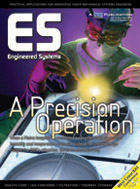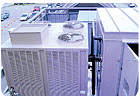
Hospital operating rooms (ORs) require tight humidity and temperature tolerances. The optimum OR environment ranges between a space temperature of 62°F to 64° db and between 50% to 60% rh. Anything outside those parameters can result in an uncomfortable OR environment.
Award-wining Franklin Memorial Hospital (Franklin Memorial) in Farmington, ME, is a nonprofit community general hospital with 70 beds. Its current building was constructed in the early 1970s. Originally, a built-up rooftop AHU with chilled water coil, 95% efficient air filters, and duct-mounted reheat coils and humidifiers served three ORs. The original installation also had the capacity to provide db-controlled economizer, which aggravated control of the space.
Since that time, changes and new programs have altered the hospital's original HVAC configuration. In particular, modifications made in 1998 and again in 2001-02 to accommodate new procedure rooms, expansions, and support areas made it nearly impossible to maintain adequate IAQ to the ORs.
The result of these changes and the need for once-through supply air for some of these new spaces exacerbated an already tenuous situation, resulting in space conditions ranging upwards of 72° db and up to 70% rh. Aggravated control and environmental issues in the ORs led the hospital to initiate the design of a completely new HVAC system for its ORs.

Franklin Memorial Hospital improved the IAQ in its operating room through the installation of a desiccant/chilled water cooling system.
ESTABLISHING REQUIREMENTS
The parameters surrounding the design and operation of a new system were as follows:- Provide improved space environmental control.
- Meet the design criteria of 62° db and 50% rh in the OR suite, even on peak cooling design days.
- Design the system within a set budget.
- Design a system to be installed and operating within a precise timeline.
- Meet the hospital's aggressive surgery schedule by minimizing the OR's down time to a maximum of two scheduled 12-hour periods.
- Design a system that is dependable, serviceable, and maintainable.
- Design a system that is energy efficient.
The first challenge was to come up with a standalone system that could be set in place, have a single-point power connection, have independent cooling capacity with district chilled water for redundancy, and was fully capable to deliver drier air, on its own, year round to the ORs. The system also had to be constructed in parallel to the existing system servicing the ORs to minimize downtime.
It was important that the new system be independent from Franklin Memorial's district chilled water system. The district chilled water system provides seasonal cooling for most hospital areas, with an average of 45

The new unit included a rooftop AHU with an air cooled scroll chiller that provided cooling capacity.
FINDING THE RIGHT SYSTEM
The next challenge was to find a system that would meet these strict design conditions, as well as be affordable to purchase and energy efficient to operate. In addition, the project required a system that could be quickly and easily installed and be fully operational as soon as the old system was taken offline.After reviewing several options, including traditional desiccant dehumidification systems, which require gas heat or steam heat for desiccant regeneration, a custom manufactured and completely packaged turnkey unit was selected. The unit was a combined desiccant/chilled water cooling system. It included a rooftop AHU, with an air cooled scroll chiller providing the cooling capacity. The patented desiccant wheel, used for enhanced humidity control, did not require supplemental heating for regeneration. The unit had its own chilled water pumps, 300-gal buffer tank, control valves, unit heater, ventilation exhaust fan, VFD, and control panel that were all located in a service vestibule that is part of the AHU.
The unit can operate as a complete standalone system and is operated from a backup emergency generator if needed. When available, the unit will also utilize the central plant chilled water through a second cooling coil installed in the new unit that can serve as a backup to the package chiller that with the air-handling system or can precool the air. The new system provides 9,400 cfm of air, of which 6,100 cfm is return and 3,300 cfm is outside air. The system can deliver 50°db air at 40° dewpoint on a peak design day. Because the two cooling coils were installed in series with the desiccant wheel, and a hydronic heating coil section was built into the unit down stream of the cooling coils, it is capable of providing drier conditioned air if necessary.
The patented dehumidification wheel is constructed of a synthetic matrix with an absorbent that is integrally bound into the matrix. The absorbent is known for its high affinity for water vapor under specified operating conditions. The absorbent is a Type III desiccant. The wheel rotates slowly, absorbing more moisture downstream of the cooling coil, and places it back to the upstream side of the cooling coils. This creates even drier air than a traditional chilled water cooling unit could ever do on its own at a set chilled water temperature.
The DOE was interested in this technology, as it appeared the cost per cfm of the level of conditioned air would be much more economical compared to a traditional mechanical (subcooling/reheat) system or a more typical desiccant wheel that requires regeneration of the desiccant media through the heating process, which imposes a significant sensible cooling load into the system.
The DOE installed their temperature sensors within the unit's outdoor air and return air mixing box upstream of the wheel, and in the discharge supply air on the downstream side of the wheel to determine the entering and leaving conditions, which translates to the actual work the wheel is performing. The wheel helps reduce the amount of cooling needed by not requiring such a low water temperature at the cooling coil, which improves the cooling efficiency and reduces the need for reheat to control humidity in the ORs.

The new unit can function as a standalone system and can be operated from a backup emergency generator, if needed.
CHALLENGING INSTALLATION
The third challenge was to orchestrate the when, where, and how of installing the unit with minimal disruption to the ORs. The hospital would only allow two downtime periods of 12 hours each. This took careful planning and communication among the hospital's facilities staff, the equipment manufacturer, and the engineer.The most important decision was determining what could be used to serve as a temporary system for the OR suite during the transition. One option was to lease a temporary system. However, that option could have increased the construction cost to a point that jeopardized the economic feasibility of the project.
It was also critical to Franklin Memorial's facility staff to establish a construction/installation timeline during the design. The staff wanted to understand how other systems within the hospital were to be affected by this work and also to identify opportunities for enhancing performance of other systems during this project.
During this systems review, we identified two AHUs over 30 years old (both 100% OA units) that served cooling and ventilation needs in other parts of the hospital and that were scheduled for replacement. It happened that both AHUs were directly above one another in two separate mechanical rooms. The team also discovered that the sum of the airflow of both units added together was roughly the same as the cfm capacity needed for the ORs.
It made sense to consolidate both maintenance and capital budgets into one. Designing a single unit to replace the two existing AHUs resulted in a reduced overall project cost and eliminated the need for an additional mechanical room. Adding this to the original OR project allowed the new replacement AHU to be used as the unit to temporarily serve the OR suite and later to be relocated and serve as a final replacement for the older units. The new AHU replacement was an indoor modular-style climate changer. Temporary measures were taken to weatherproof the replacement AHU to withstand the outdoor elements and be capable of serving the OR suite temporarily, until the new permanent replacement was fabricated and delivered and the utilities were prepared to serve the new installation.
The removal of old systems and installation of the new desiccant HVAC system was successful. The transitions in construction took less time than the two 12-hour shutdowns allowed (only 12 hrs and 8 hrs). No glitches occurred. What could have been done better during preparation was testing the integrity of the existing duct distribution system to the OR suite. We experienced 10% to 20% duct leakage in this duct system, which resulted in additional work to identify and seal the leaks.
The new OR suite HVAC system has been in operation since June 2005 and has provided superb control and environmental conditions. The OR environment is 62° db and 50% rh. Interestingly, during the first two months of operation, approximately 50% of the supply air was outside ambient compared to the designed quantity of 30%, yet the system still maintained consistent conditions in high and low load conditions.
